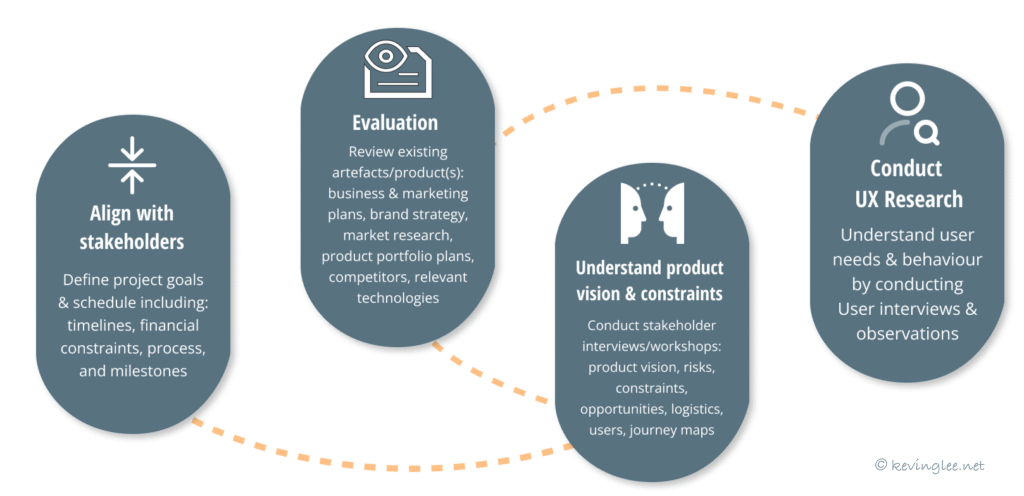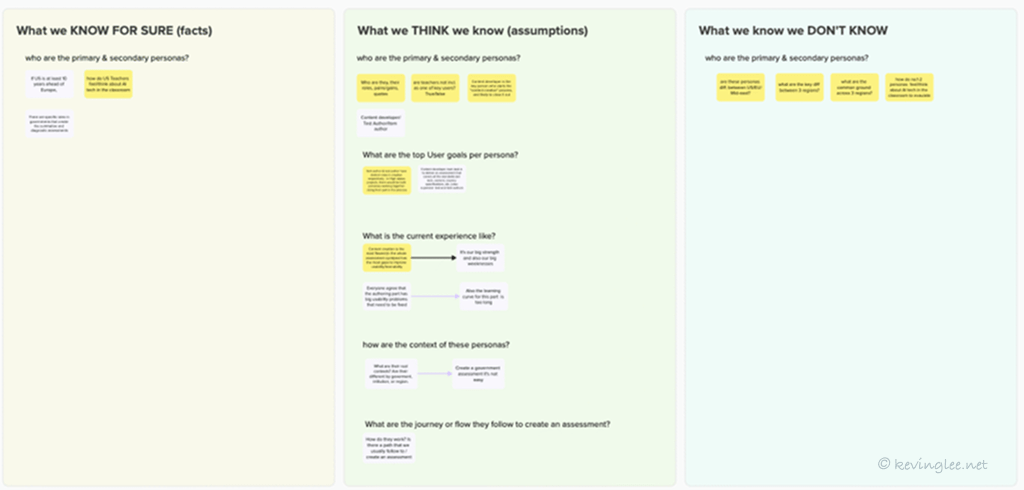
Part 1 (of 5) of the Qualitative UX Research Playbook series
Take this typical scenario: your team is embarking on a new product, but several stakeholders or colleagues differ in opinion on who the primary User is or what the focus should be. At the same time, leadership is pushing for a feature-rich solution that could appeal to multiple customer segments. Without alignment, the team risks overloading the product with conflicting goals, diluting its value for any specific user group.
Where do you begin?
Qualitative UX research has proven countless times that it yields the best answers. However, the success of any research effort depends on how well you plan and prepare. Especially in qualitative UXR, without a clear strategy, research can drift, become unfocused, or fail to yield quality insights. In this blog—the first in a 5-part series on Planning and Executing Qualitative UXR—we’ll explore how to lay a strong foundation for research efforts. This includes starting with discovery, setting clear research priorities, and articulating effective research goals. These steps are critical, especially for foundational exploratory research, to make sure your qualitative study starts off correctly.
1. Start with discovery
Discovery is the primer for UXR which we cannot afford to skip. It’s where teams align, clarify goals, and ensure efforts are focused and relevant. Without this step, research risks being scattered or misaligned with both User and business needs.
- Align with key stakeholders around two key priorities: User needs and business goals. Workshop with your team to map out stakeholders in the project. What does each stakeholder care about (e.g., increased revenue, user satisfaction, technical feasibility)? Understanding the key business drivers is as important as discovering who the Users & needs are.
- Evaluate existing artefacts to avoid duplication and save valuable time. Analyse past research, brand or business strategies, usability tests, analytics, and competitor benchmarks to uncover patterns or gaps. Many UXers call this process “UX Audit” while I prefer “Evaluate” as it is closer to the action of the task than a term associated with finance. =)
- Understand the product vision and constraints early. Align on what “success’ is and how it’s articulated in words while acknowledging limitations such as technical feasibility, budgets, or tight timelines. This enables you to manage realistic expectations for your research and design efforts from the very start. By understanding the business’s strategic objectives (e.g. growth, retention, conversion) to ensure that research outcomes support the organisation’s success.
In our UX discipline, orgs with high UX maturity applies Strategic UXR (UX Research) which advocates aligning User insights with business goals to inform long-term product strategy, prioritisation, and innovation decisions. - Foster collaboration through cross-functional workshops. Use these sessions to map assumptions, validated facts, visualise User journeys, and identify knowledge gaps. Incorporate early personas and scenarios to ground discussions in real user goals and behaviours.

User personas typically start with assumptions. Hypothesis-driven ‘placeholder personas,’ built on existing knowledge or assumptions during the discovery phase is common and quite useful as a starting point. If you have some facts already, even better. These can be refined/updated later but provide early clues (albeit sketchy) for identifying key user groups in order to recruit the right interview participants. Once the research data starts flowing in, you’ll have a higher fidelity of the personas based on facts, not uncommonly on a daily basis. For this reason of rapid data in-flow, many advocate Proto-personas being effective and flexible. I agree.
Context scenario mapping is a powerful tool. Use context scenarios to explore how Users might interact with the product. For instance, ask: ‘What steps would a new User take to complete onboarding, and why?’ This approach helps uncover knowledge gaps and misaligned assumptions, especially during stakeholder workshops. Typically Proto-persona (or User persona) boards should produce enough clues what their goals & motivations/frustrations are; which leads into what context scenarios they are faced with.
Similar to working with placeholder personas above, working with assumptions on context scenarios in the initial steps is normal. These steps provide valuable clues for UXR to validate and uncover factual data. Conversely starting from zero would mean more time & resources spent otherwise.
For high-stakes UX projects, discovery is not just a starting point—it’s fundamental and should be a key accelerator to your research.
2. Define what to learn first and next…
Effective UX research starts with clear priorities. Focus on immediate knowledge gaps to get orientated on what needs further investigative work, a re-do, or to skip. Ask key questions like:
- Who are our primary & secondary User personas?
- What are their goals and pain points? To which context scenarios do they apply?
- What’s the priority focus for the UX team to validate?
“What we know as facts” workshop
To structure this, I can recommend the “What we know” exercise using 3 boards in Miro or Mural (digital infinite boards) in a workshop. Simply create 3 frames with the following labels:
- What we know as FACTS: Using post-it notes, each assumption/data gets noted as atomic notes. Place and cluster into this board the validated insights from past research or analytics
- What we THINK “we know”: Place into this board the unproven assumptions that has yet to be validated (e.g., “We think onboarding feels too complex”). You can weigh up what is high/low priority to do during the workshop and rank them
- What we KNOW we DON’T know: Place into here the unanswered questions your research must address (e.g., “What are the biggest blockers in navigation?”).

Seeing the 3 clusters of data (in their varying degrees of fidelity) enables us to see what is done, and what needs more UX work in a single view. This is much more effective if done collaboratively as a team or as a group in a workshop providing space for debate and discussion.
The above facilitate us to focus on key areas to research, challenges assumptions, and reduce scope where needed. It also encourages cross-team collaboration by aligning everyone on what’s known, assumed, and unknown. By clarifying what to learn first and next, you ensure your research is purposeful and aligned with both user needs and business goals.
3. Articulate target research goals
Target research goals act as the project compass of your study, ensuring that your research efforts can work with velocity and consistency when research work (when getting in the weeds) can become a quite messy affair. Clear goals help maintain focus and prevent research from drifting into unrelated areas, saving valuable time.
How to articulate goals
Identify Items or Assumptions to Explore further. Use outputs from earlier exercises like the “Three Boards” (facts, assumptions, unknowns) to pinpoint the most critical areas to validate or investigate. For example: If an assumption is “We think Users abandon onboarding because it’s too complex,” the research goal becomes: “Understand Users’ challenges during onboarding.”
“Exploratory research focuses on understanding the problem space, rather than jumping directly into creating solutions.“
— Kim Goodwin, Designing for the Digital Age
Frame Goals Around What You NEED to Learn based on your discovery work. An example of a well-framed research goal can be:
“Identify the reasons why Users abandon the onboarding process and what factors influence their willingness to complete it.”
This results in concise set of research goals tied to specific knowledge gaps or assumptions, acting as a guide to craft focused research questions.
Use goals to guide and focus the study
Once your goals are articulated, they become a framework for keeping the study on track. Research goals act as parameters, ensuring that every question, method, and participant choice is aligned with what you need to learn. Goals enables the study remains focused, guiding decisions on questions, methods, and participant selection. This clarity prevents the collection of irrelevant or unfocused data.
“Well-defined goals help you avoid the ‘everything bucket’ problem—where you try to learn too much at once and end up with vague, unfocused data.”
— Erika Hall, Just Enough Research
4. Review and align with teammates & stakeholders
Collaboration and alignment are critical to ensure research goals address both User needs and business priorities. Involving teammates and stakeholders in the process fosters alignment and creates a shared understanding of the study’s direction.
Present Draft Goals if key stakeholders of teammates have not been kept in the loop: Share the initial research goals with your teammates and stakeholders. Provide context by explaining:
- The assumptions or knowledge gaps the goals are addressing.
- How the goals align with broader project objectives or success metrics.
Facilitate Feedback by asking stakeholders “Do these goals address the most critical unknowns for the project?” Or “Are there additional knowledge gaps or priorities we need to include?”
Be open to incorporating feedback, but ensure the goals remain focused on the problem space rather than diverging into unrelated areas.
“When you align the team around a shared understanding of the problem, you create a much stronger foundation for success.”
— Alan Cooper, About Face: The Essentials of Interaction Design
Cooper’s insight underscores the importance of ensuring everyone is aligned on the research goals. A shared understanding strengthens collaboration and steers the research direction is clear and supported.
5. Document the final goals
Once goals are reviewed and aligned, insert them to the Research Brief and plan. This document should include:
- The target research goals.
- The rationale behind each goal.
- Alignment with both User needs and business objectives.
Example of a Finalised Research Goal Framework can look like this:
Target research goal:
Understand the challenges Users face during onboarding and the motivations behind whether they complete the process or abandon it.
Tied Assumption: “We think Users find the onboarding process too complex.”
Key benefits of well-crafted research goals
Goals help provide focus. They guide the study with clear objectives, preventing unintentional scope creep, whether initiated by stakeholders or even by yourself during the process. UXR studies are projects like any other in this regard.
Alignment and relevance are additional benefits of having research goals. By creating a shared understanding among team members and stakeholders, they help reduce miscommunication or conflicting priorities. Additionally, by being documented and clearly articulated, they serve as valuable indicators to verify that both User needs and business goals are thoughtfully addressed in the endeavour.
With your goals in place, the next step is to explore the tools and methods available to conduct your study effectively. In this first part of the series, I’ve highlighted best practices for the planning stage—an often critical phase in exploratory research—and covered the essentials. While some steps may be skipped for smaller studies or evaluative research conducted later in the product cycle, foundational research demands careful attention to these fundamentals. In Part 2 of The UX Research Playbook series, we’ll explore various instrumentation options for your research and discuss how to recruit the right participants.
This was Part 1 (of 5) of the UX Research Playbook series.
- View Part 2: Instrumentation & Recruitment – Setting the Stage for Effective User Interviews
- View Part 3: Mastering the Art of User Interviews: Listening to Learn
- View Part 4: From Raw Data to Clarity – Cleaning, Sorting, and Synthesising Insights
Recommended further reading
- Just Enough Research by Erika Hall
- Designing for the Digital Age by Kim Goodwin
- Contextual Design: Defining Customer-Centered Systems by Karen Holtzblatt and Hugh Beyer
- Interviewing Users: How to Uncover Compelling Insights by Steve Portigal


